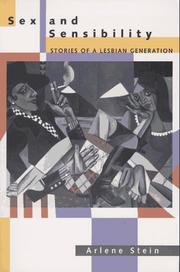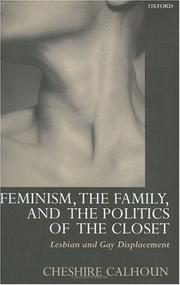| Listing 1 - 9 of 9 |
Sort by
|

ISBN: 9786612071492 1282071491 0253111226 9780253111227 9780253344540 0253344549 9780253217134 025321713X 9781282071490 6612071494 Year: 2004 Publisher: Bloomington : Indiana University Press,
Abstract | Keywords | Export | Availability | Bookmark
 Loading...
Loading...Choose an application
- Reference Manager
- EndNote
- RefWorks (Direct export to RefWorks)
""No matter how wise a mother's advice is, we listen to our peers."" At least that's writer Naomi Wolf's take on the differences between her generation of feminists -- the third wave -- and the feminists who came before her and developed in the late '60s and '70s -- the second wave. In Not My Mother's Sister, Astrid Henry agrees with Wolf that this has been the case with American feminism, but says there are problems inherent in drawing generational lines.Henry begins by examining texts written
African American women. --- Lesbian feminist theory --- Feminist theory --- Third-wave feminism --- Afro-American women --- Women, African American --- Women, Negro --- Women --- Lesbian feminism --- Lesbian feminist sociology --- Theory of lesbian feminism --- Feminism --- Philosophy

ISBN: 0585022682 9780585022680 025333246X 0253210844 9780253332462 9780253210845 Year: 1997
Abstract | Keywords | Export | Availability | Bookmark
 Loading...
Loading...Choose an application
- Reference Manager
- EndNote
- RefWorks (Direct export to RefWorks)
". . . innovative and important thinking about the various relations between feminist theory, queer theory, and lesbian theory, as well as the possibility that liberation can be mutual rather than mutually exclusive." --Lambda Book Report"Challenging and interesting." --Just OutA collection of fifteen interdisciplinary essays examining the history, current condition, and evolving shape of lesbian alliances with U.S. feminists. Contributors explore the social and aesthetic significance of the terms "lesbian" and "feminist" with the interest of reforming and strengthening them.
Lesbian feminism. --- Lesbian feminist theory. --- Lesbianism. --- Lesbians --- Identity. --- Lesbianism --- Feminist Theory --- Social Science --- Feminist theory --- Social science
Book
ISBN: 3030695557 3030695549 9783030695552 Year: 2021 Publisher: Cham, Switzerland : Palgrave Macmillan,
Abstract | Keywords | Export | Availability | Bookmark
 Loading...
Loading...Choose an application
- Reference Manager
- EndNote
- RefWorks (Direct export to RefWorks)
The purpose of this Handbook is to provide students with an overview of key developments in queer and trans feminist theories and their significance to the field of contemporary performance studies. It presents new insights highlighting the ways in which rigid or punishing notions of gender, sexuality and race continue to flourish in systems of knowledge, faith and power which are relevant to a new generation of queer and trans feminist performers today. The guiding question for the Handbook is: How do queer and trans feminist theories enhance our understanding of developments in feminist performance today, and will this discussion give rise to new ways of theorizing contemporary performance? As such, the volume will survey a new generation of performers and theorists, as well as senior scholars, who engage and redefine the limits of performance. The chapters will demonstrate how intersectional, queer and trans feminist theoretical tools support new analyses of performance with a global focus. The primary audience will be students of theatre/ performance studies as well as queer /gender studies. The volume's contents suggest close links between the formation of queer feminist identities alongside recent key political developments with transnational resonances. Furthermore, the emergence of new queer and trans feminist epistemologies prompts a reorientation regarding performance and identities in a 21st-century context.
Gays and the performing arts. --- Feminism and the arts. --- Transgender people. --- Queer theory. --- Lesbian feminist theory. --- Lesbian feminism --- Lesbian feminist sociology --- Theory of lesbian feminism --- Feminist theory --- Gender identity --- TG people --- TGs (Transgender people) --- Trans-identified people --- Trans people --- Transgender-identified people --- Transgendered people --- Transgenders --- Transpeople --- Persons --- Arts and feminism --- Arts --- Performing arts and gays --- Performing arts --- Philosophy --- Gay people and the performing arts.

ISBN: 1134859716 0203147820 1280327413 9780203147825 9780415098021 0415098025 9780415098038 0415098033 0415098025 0415098033 9781280327414 9781134859719 9781134859665 9781134859702 Year: 1995 Publisher: London ; New York : Routledge,
Abstract | Keywords | Export | Availability | Bookmark
 Loading...
Loading...Choose an application
- Reference Manager
- EndNote
- RefWorks (Direct export to RefWorks)
Are bodies sexy? How? In what sorts of ways? Sexy Bodies investigates the production of sexual bodies and sexual practices, of sexualities which are dyke, bi, transracial, and even hetero. It celebrates lesbian and queer sexualities but also explores what runs underneath and within all sexualities, discovering what is fundamentally weird and strange about all bodies, all carnalities. Looking at a pleasurable variety of cultural forms and texts, the contributors consider the particular charms of girls and horses, from National Velvet to Marnie; discuss figure
Sex. --- Homosexuality. --- Lesbianism. --- Lesbian feminism. --- Feminism --- Female homosexuality --- Lesbian love --- Sapphism --- Homosexuality --- Women --- Same-sex attraction --- Sexual orientation --- Bisexuality --- Gender (Sex) --- Human beings --- Human sexuality --- Sex (Gender) --- Sexual behavior --- Sexual practices --- Sexuality --- Sexology

ISBN: 1134883447 020341988X 128033651X 9780203419885 9780415086554 0415086558 9780415086561 0415086566 0415086558 0415086566 9781280336515 9781134883448 9781134883394 9781134883431 1134883439 Year: 1995 Publisher: London ; New York : Routledge,
Abstract | Keywords | Export | Availability | Bookmark
 Loading...
Loading...Choose an application
- Reference Manager
- EndNote
- RefWorks (Direct export to RefWorks)
An academic approach to both gender and the erotic, which clarifies the damaging influence of heterosexism and examines Lesbian treatment in sociology, psychology, social policy, cultural studies, film theory and history.
Gay and lesbian studies. --- Feminist theory. --- Gay studies --- Homophile studies --- Lesbian and gay studies --- Lesbian studies --- Education --- Feminism --- Feminist philosophy --- Feminist sociology --- Theory of feminism --- Curricula --- Philosophy --- Lesbian feminism.

ISBN: 0520918312 0585032890 9780520918313 9780585032894 0520202570 0520206746 Year: 1997 Publisher: Berkeley, California : University of California Press,
Abstract | Keywords | Export | Availability | Bookmark
 Loading...
Loading...Choose an application
- Reference Manager
- EndNote
- RefWorks (Direct export to RefWorks)
In the first book to analyze shifts in lesbian identity, consciousness, and culture from the 1970s to the 1990s, Arlene Stein contributes an important chapter to the study of the women's movement and offers a revealing portrait of the exchange between a radical generation of feminists and its successors. Tracing the evolution of the lesbian movement from the bar scene to the growth of alternative families, Stein illustrates how a generation of women transformed the woman-centered ideals of feminism into a culture and a lifestyle. Sex and Sensibility relates the development of a "queer" sensibility in the 1990s to the foundation laid by the gay rights and feminist movements a generation earlier. Beginning with the stories of thirty women who came of age at the climax of the 70s women's movement--many of whom defined lesbianism as a form of resistance to dominant gender and sexual norms--Stein explores the complex issues of identity that these women confronted as they discovered who they were and defined themselves in relation to their communities and to society at large. Sex and Sensibility ends with interviews of ten younger women, members of the post-feminist generation who have made it a fashion to dismiss lesbian feminism as overly idealistic and reductive. Enmeshed in Stein's compelling and personal narrative are coming-out experiences, questions of separatism, work, desire, children, and family. Stein considers the multiple identities of women of color and the experiences of intermittent and "ex" lesbians. Was the lesbian feminist experiment a success? What has become of these ideas and the women who held them? In answering these questions, Stein illustrates the lasting and profound effect that the lesbian feminist movement had, and continues to have, on contemporary women's definitions of sexual identity.
Lesbianism --- Lesbians --- Identity (Psychology) --- Lesbian feminism --- Gender & Ethnic Studies --- Social Sciences --- Gay & Lesbian Studies --- Feminism --- Personal identity --- Personality --- Self --- Ego (Psychology) --- Individuality --- Female gays --- Female homosexuals --- Gay females --- Gay women --- Gayelles --- Gays, Female --- Homosexuals, Female --- Lesbian women --- Sapphists --- Women, Gay --- Women homosexuals --- Gays --- Women --- Female homosexuality --- Lesbian love --- Sapphism --- Homosexuality --- Sexual behavior --- Lesbians. --- Lesbian feminism. --- SOCIAL SCIENCE / Lesbian Studies. --- 20th century lgbtqia culture. --- alternative families. --- bar scene. --- coming out experiences. --- desire. --- dominant gender norms. --- dominant sexual norms. --- ex lesbians. --- feminism. --- form of resistance. --- gay and lesbian studies. --- gay rights. --- gender studies. --- identity. --- lesbian consciousness. --- lesbian culture. --- lesbian feminism. --- lesbian identity. --- lesbian movement. --- lgbt demographic studies. --- lgbtqia. --- performance of sexuality. --- post feminist generation. --- radical feminists. --- separatism. --- sex and gender. --- sexual identity. --- sexuality. --- womens movement.

ISBN: 081475595X 0814759718 9780814759714 Year: 1998 Publisher: New York, NY : New York University Press,
Abstract | Keywords | Export | Availability | Bookmark
 Loading...
Loading...Choose an application
- Reference Manager
- EndNote
- RefWorks (Direct export to RefWorks)
Many of us have grown up with the language of civil rights, yet rarely consider how the construction of civil rights claims affects those who are trying to attain them. Diane Miller examines arguments lesbians and gay men make for civil rights, revealing the ways these arguments are both progressive--in terms of helping to win court cases seeking basic human rights--and limiting--in terms of framing representations of gay men and lesbians. Miller incorporates case studies of lesbians in the military and in politics into her argument. She discusses in detail the experiences of Colonel Margarethe Cammermeyer, who was dishonorably discharged from the National Guard after 27 years of service when she revealed that she was a lesbian, and Roberta Achtenberg, who was nominated by Clinton for the job of Assistant Director of Housing and Urban Development and became the first gay or lesbian to face the confirmation process. Drawing on these cases and their outcomes, Miller evaluates the advantages and disadvantages of privileging civil rights strategies in the struggle for gay and lesbian rights.
Achtenberg, Roberta. --- Cammermeyer, Margarethe, 1942-. --- Gay rights -- United States -- History. --- Lesbian feminism -- United States. --- Lesbians -- Legal status, laws, etc. -- United States. --- Women’s rights -- United States -- History. --- Gay rights --- Lesbians --- Women's rights --- Lesbian feminism --- Gender & Ethnic Studies --- Social Sciences --- Gay & Lesbian Studies --- History --- Legal status, laws, etc --- Female gays --- Female homosexuals --- Gay females --- Gay women --- Gayelles --- Gays, Female --- Homosexuals, Female --- Lesbian women --- Sapphists --- Women, Gay --- Women homosexuals --- Gay and lesbian rights --- Gay men --- Gays --- Lesbian rights --- Rights of gays --- Rights of lesbians --- Civil rights --- Women --- Feminism --- Legal status, laws, etc. --- Women's rights -- United States -- History. --- History.

ISBN: 1281943835 9786611943837 0191522511 9780191522512 0198295596 9780198295594 Year: 2000 Publisher: Oxford ; New York : Oxford University Press,
Abstract | Keywords | Export | Availability | Bookmark
 Loading...
Loading...Choose an application
- Reference Manager
- EndNote
- RefWorks (Direct export to RefWorks)
How has feminism failed lesbianism? What issues belong at the top of a lesbian and gay political agenda? This book answers both questions by examining what lesbian and gay subordination really amounts to. Calhoun argues that lesbians and gays aren't just socially and politically disadvantaged. The closet displaces lesbians and gays from visible citizenship, and both law and cultural norms deny lesbians and gay men a private sphere of romance, marriage, and the family. - ;Feminism, the Family, and the Politics of the Closet is about placing sexual orientation politics within feminist theorizing
Lesbian feminism --- Lesbian feminist theory --- Lesbians --- Sexual orientation --- Oppression (Psychology) --- Gay men --- Gays, Male --- Homosexuals, Male --- Male gays --- Male homosexuals --- Urnings --- Gays --- Men --- Female gays --- Female homosexuals --- Gay females --- Gay women --- Gayelles --- Gays, Female --- Homosexuals, Female --- Lesbian women --- Sapphists --- Women, Gay --- Women homosexuals --- Women --- Criminal psychology --- Personality --- Psychology --- Social psychology --- Orientation, Sexual --- Sexual preference --- Sex (Psychology) --- Sexual reorientation programs --- Lesbian feminist sociology --- Theory of lesbian feminism --- Feminist theory --- Feminism --- Identity. --- Political aspects --- Political activity. --- Philosophy --- Political activity --- Sociology of minorities --- Sociology of the family. Sociology of sexuality --- Politics --- Sexology --- United States --- Conversion therapy --- United States of America --- Gender --- Family --- Heteronormativity --- Gay marriages --- Homosexuality --- Female homosexuality --- Lesbian relationships --- Romantic and sexual orientation --- Theory --- Book --- Discrimination
Book
ISBN: 022618787X 9780226187877 9780226187563 9780226187730 022618756X 022618773X 1322335087 Year: 2014 Publisher: Chicago : University of Chicago Press,
Abstract | Keywords | Export | Availability | Bookmark
 Loading...
Loading...Choose an application
- Reference Manager
- EndNote
- RefWorks (Direct export to RefWorks)
The period of reform, revolution, and reaction that characterized seventeenth- and eighteenth-century Europe also witnessed an intensified interest in lesbians. In scientific treatises and orientalist travelogues, in French court gossip and Dutch court records, in passionate verse, in the rising novel, and in cross-dressed flirtations on the English and Spanish stage, poets, playwrights, philosophers, and physicians were placing sapphic relations before the public eye. In The Sexuality of History, Susan S. Lanser shows how intimacies between women became harbingers of the modern, bringing the sapphic into the mainstream of some of the most significant events in Western Europe. Ideas about female same-sex relations became a focal point for intellectual and cultural contests between authority and liberty, power and difference, desire and duty, mobility and change, order and governance. Lanser explores the ways in which a historically specific interest in lesbians intersected with, and stimulated, systemic concerns that would seem to have little to do with sexuality. Departing from the prevailing trend of queer reading whereby scholars ferret out hidden content in "closeted" texts, Lanser situates overtly erotic representations within wider spheres of interest. The Sexuality of History shows that just as we can understand sexuality by studying the past, so too can we understand the past by studying sexuality.
Lesbians in literature. --- Lesbians' writings --- European literature --- Lesbianism --- Lesbian feminism --- Feminism --- Female homosexuality --- Lesbian love --- Sapphism --- Homosexuality --- Women --- Writings of lesbians --- Literature --- History and criticism. --- History. --- Sexual behavior --- sexuality, homosexuality, lesbians, women, gender, queer, sappho, lgbtq, lgbt, lgbtqia, france, holland, cross dressing, intimacy, friendship, love, romance, authority, liberty, power, difference, desire, duty, mobility, change, order, governance, erotics, nonfiction, literature, drama, culture, history, family, revolution, resistance, deviance, europe, england, british, rise of the novel, performance, theater, stage, poetry, play, passion.
| Listing 1 - 9 of 9 |
Sort by
|

 Search
Search Feedback
Feedback About UniCat
About UniCat  Help
Help News
News